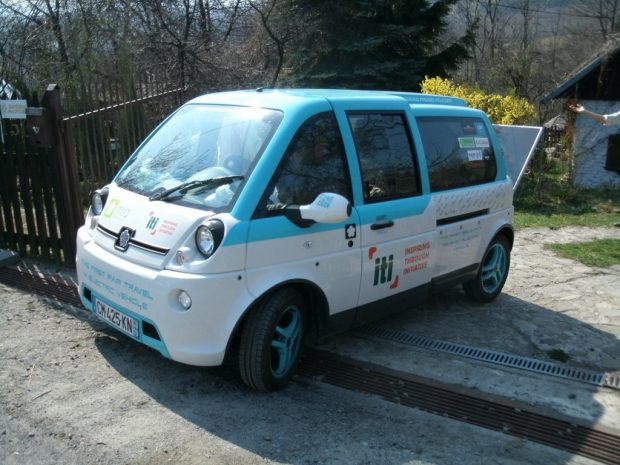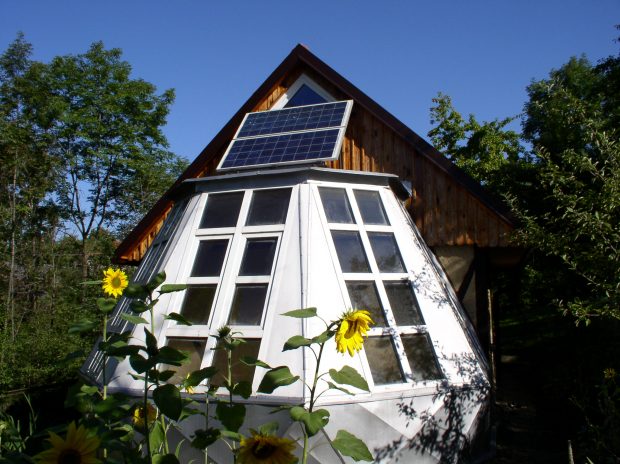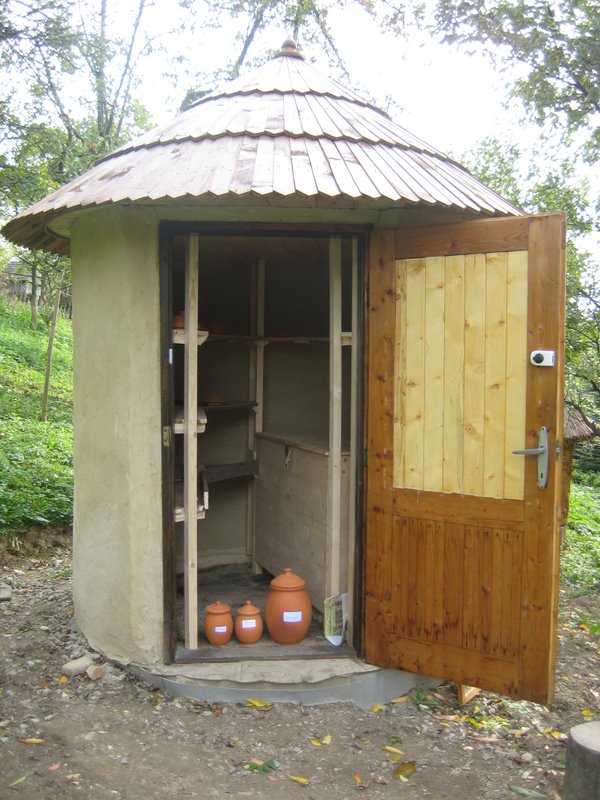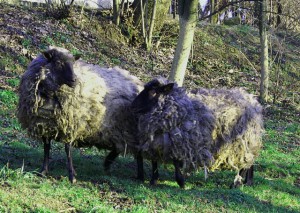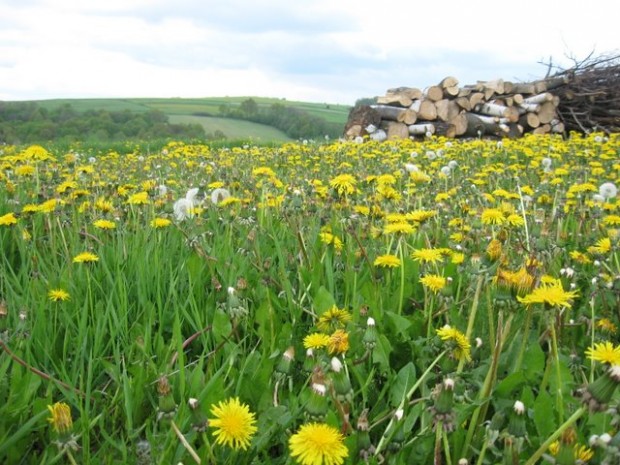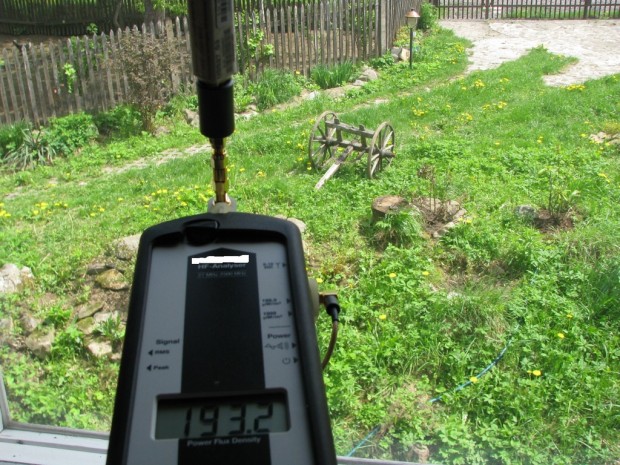Electric car
„MIA electric” car in our centre. [Show slideshow] Pin it
The small house
Pin it The small house also made of clay and straw but using different technique. It was built in five weeks during workshops for youths. It has a wooden framework filled with a mixture of clay and straw. The external walls are thick (45 cm) and no additional insulation is necessary. This house is totally […]
A solar tracker
A solar tracker or tracking system is an undercostruction that follows the sun. Our tracker is equipped with a time controller and „follows” the sun from east to west. Thanks to the use of a tracking system we can generate even 30% more energy! Pin it
FOTOWOLTAIKA WŚRÓD ZIÓŁ I KWIATÓW ? EKOCENTRUM ICPPC
Zofia Pasternak
W miejscowości Stryszów, 50 km od Krakowa, znajduje się Ekocentrum ICPPC ? miejsce niepozorne, ale bardzo szczególne. Położone w otoczeniu zieleni, w sadzie, w którym rosną stare odmiany drzew owocowych i mnóstwo kwiatów, składa się z ogrodu oraz kilku budynków, w tym dwóch zbudowanych z gliny i słomy. Miejsce dobrej energii. Tutaj częstują herbatą z mieszaniny ziół uprawianych według kalendarza biodynamicznego we własnym ogródku ziołowym, a do jedzenia podają zdrowe ekologiczne posiłki na bazie produktów pochodzących od lokalnych rolników. Są też i zwierzęta: kot, pies, oraz tradycyjne rasy – kury zielononóżki kuropatwiane, owieczki wrzosówki.
W Ekocentrum kultywuje sie tradycje polskiej wsi, ale nie tylko. Jest to przede wszystkim miejsce, w którym technologia współgra z naturą, a tradycja łączy się z nowoczesnością. Znaleźć tu można szereg nowoczesnych rozwiązań: elektrownie fotowoltaiczne, system hybrydowy słońce-wiatr, kolektory słoneczne, oczyszczalnię ścieków, świetliki rurowe, toaletę z segregacją frakcji. I są to nie tylko instalacje pokazowe. Tutaj wszystkie urządzenia pracują, zasilając budynki, oczyszczając ścieki, ogrzewając wodę i pomieszczenia.
Quit The Matrix Build The Ark
Date: will be specified
PROGRAMME:
1st day – From 14:00 – accommodation in small holding POTOCZEK 19:00 – dinner from local organic produce
2nd day 9:00 – 10:00 – breakfast from local organic produce 10:00 – 11:00 – Our Ark (part I) – visiting ECOCENTRE ICPPC 11:00 – 12:30 – „Quit the Matrix Build the Ark – In Three Steps” introduction by Sir Julian Rose, president of International Coalition to Protect the Polish Countryside-ICPPC, farmer, activists and the author of the books 12:30 – 13:30 – „Our Ark (part II) ECOCENTRE ICPPC, its history and current activities” by Jadwiga Lopata, the leading Polish activist, laureat of Goldman Prize (ecological Nobel Prize) 14:00 – 15:00 – Lunch from local, ecological products 15:00 – 17:00 – Our Ark (part III) – „On the Way to Food Independence” – guided visit to the farm and workshop (how to grow and preserve food, making compost, save seeds) – Jadwiga Łopata and Julian Rose 19:00 – dinner from local organic produce
3rd day 10:00 – 11:30 – „Loan-Free, Energy Saving and Healthy House”, presentation by Krzysztof Wietrzny, expert practitioner of ecological technology and creator of ECOCENTRE ICPPC 11:30 – 12:30 – „Micro-scale energy independence systems for production of green energy for heating and electricity in the home” – presentation by Krzysztof Wietrzny 13:00 – 14:00 – Lunch from local, ecological products 14:00 – 17:00 – Seasonal and healthy eating. Local action plan by Julian Rose and Jadwiga Lopata 17:00 – 18:00 – Summary 19:00 – dinner from local organic produce
4th day 8:30 – 9:30 – breakfast from local organic produce
Owieczki
Od roku 2007 można również w EKOCENTRUM zobaczyć owce rasy „wrzosówki”. Owca rasy wrzosówka jest jedną z najmniejszych ras owiec hodowanych w Polsce. Rodzimym obszarem jej występowania były północno-wschodnie kresy naszego kraju. Wywodzi się od północnych owiec krótko ogoniastych (ovis brachyra borealis). Wrzosówki są najstarszą polską rasą owiec. Poprzez swoją niezwykłą odporność oraz małe wymagania […]
Permakultura
Współdziałać z naturą
Koncepcja Permakultury pochodzi z Tasmanii (Australia). Jest wynikiem współpracy Billa Mollisona i Davida Holmgrena we wczesnych latach siedemdziesiątych. Mollison założył Instytut Permakultury w Stanley w Tasmanii a równocześnie rozwijał 67 hektarowe gospodarstwo permakulturowe, gdzie testował wiele nowych pomysłów.
?Permanentna kultura? (trwała uprawa, rolnictwo) jest sposobem świadomego projektowania i utrzymania produktywnych rolniczych ekosystemów, które mają różnorodność, stabilność i odporność naturalnego ekosystemu.
A model envisioned in „Small Is Beautiful” is possible in reality
A model envisioned in „Small Is Beautiful” is possible in reality – welcoming to the Polish countryside.
In the early 1970?s, Fritz Schumacher wrote the book „Small Is Beautiful” and proposed ?an economics as though people mattered? comprising small scale, flexible and ecologically sensitive developments as the long term solution for preserving the planet and the quality of life of its populace. Three decades on, we seem to be no nearer to applying the wisdom inherent in Schumacher?s work.
It is not just the loss of lively hoods and poisoning of the soil that marks this out as the worst crisis to have hit the countryside in centuries, but it is the loss of „a whole way of life” and the great store of knowledge and wisdom that goes with it. Today, a handful of transnational corporations control a high percentage of commercial agricultural activities in Europe and North America ? and a similarly small number of supermarkets dominate the market place.
DOMY Z KONOPI
W dniach 21-22 czerwca 2013 roku w Krakowie-Tyńcu, w siedzibie Spółdzielni Socjalnej Ekocentrycy, odbyły się wykłady i warsztaty praktyczne, dotyczące technologii budowy domów z konopi. W zajęciach uczestniczyła grupa ok. 30 osób – z całej Polski (w tym również autor niniejszego tekstu), a także kilku gości zagranicznych – wszyscy wyjątkowo pozytywnie „zakręceni”. Więcej: http://posadzkrzak.pl/domy-z-konopi/
Healthy Home – protection against harmful microwave radiation.
Date: will be specified Price of the workshop: – 190 PLN per person For more details please apply now to: ICPPC – International Coalition to Protect the Polish Countryside, 34-146 Stryszów 156, Poland, tel./fax +48 33 8797114, biuro@icppc.pl www.icppc.pl www.eko-cel.pl Accommodation in Potoczek www.potoczek.pl (you are welcome to come earlier and stay longer). There is […]
